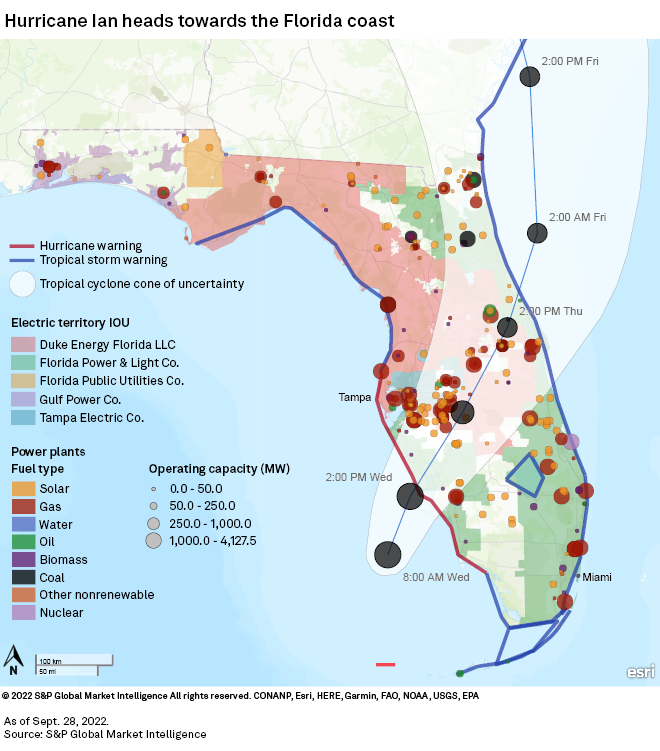S&P Global Offerings
Featured Topics
Featured Products
Events
S&P Global Offerings
Featured Topics
Featured Products
Events
S&P Global Offerings
Featured Topics
Featured Products
Events
Banking & Capital Markets
Economy & Finance
Energy Transition & Sustainability
Technology & Innovation
Podcasts & Newsletters
Banking & Capital Markets
Economy & Finance
Energy Transition & Sustainability
Technology & Innovation
Podcasts & Newsletters
S&P Global Offerings
Featured Topics
Featured Products
Events
27 Sep, 2022
By Darren Sweeney and Anna Duquiatan

Utilities in Florida on Sept. 27 were bracing for a potentially deadly and destructive hurricane that could cause widespread outages and impact available generation.
As of 5 p.m. ET on Sept. 27, the National Hurricane Center predicted tropical-storm-force winds hitting the southwest coast of Florida during the evening and moving across the state and into southern Georgia on Sept. 28. The hurricane center warned of storm surge of up to 8 feet to 12 feet, and rainfall in central and northeast Florida averaging 12 inches to 18 inches. Hurricane Ian made landfall at 4:30 a.m. Sept. 27 in western Cuba as a Category 3 hurricane with sustained winds of 125 mph, according to the National Hurricane Center.
 |
Based on the current path of the storm, about 9 million retail electricity customers in Florida could be impacted, according to an S&P Global Market Intelligence analysis. In addition, the analysis shows 26 power plants with an operating capacity of at least 1,000 MW in Florida are located in the potential path of the storm. More than 30,000 MW of nuclear capacity, including plants in Georgia, South Carolina, North Carolina and Virginia, also is in the storm's path.
NextEra Energy Inc. utility subsidiary Florida Power & Light Co., which serves more than 5 million electric customers in Florida, said it has assembled about 16,000 workers "that will be deployed into the field safely and as quickly as possible to respond to power outages from Hurricane Ian."
"We are already seeing some impacts from the storm," FPL Chairman and CEO Eric Silagy said during a Sept. 27 press briefing. "There are significant feeder bands that are starting to come onshore in South Florida."
Silagy warned that a lot of land is already "very saturated" from significant rainfall in recent weeks, which is likely to contribute to downed trees.
"This is a very slow-moving storm," Silagy said. "It is predicted to slow down as it approaches Florida and then when it makes landfall to continue to be very slow as it moves across the state."
With significant rainfall, storm surge and flooding expected, the utility also is taking a cautious approach with its baseload generation assets. FPL operates a large natural gas-fired fleet in Florida, in addition to the 1,990-MW St. Lucie nuclear plant in St. Lucie County and the 1,707-MW Turkey Point Nuclear plant in Miami-Dade County.
"There are no plans at this time to shut down generation facilities," Silagy said, though the utility is monitoring whether to shut down the 1,638-MW Manatee gas-fired power plant because of high winds.

If hurricane-force winds start to affect FPL's nuclear assets, "then we would start the process to safely shut them down," Silagy said.
Silagy added that FPL's storm hardening efforts over the last several years "have paid off significantly" by protecting infrastructure and reducing restoration times.
"But I want to be clear, there is no such thing as a hurricane-proof electrical grid," Silagy said.

Duke Energy Corp. subsidiary Duke Energy Florida LLC serves nearly 1.9 million retail electric customers and operates several large natural gas-fired power plants in Florida, including the 2,169-MW Hines Energy Complex in Polk County.
Duke, in a Sept. 27 news release, said it was mobilizing nearly 10,000 workers in its Florida service territories who can respond to outages as safety allows. In addition, lineworkers and support personnel from Duke's Midwest service territories are expected to provide mutual assistance.
Emera Inc. subsidiary Tampa Electric Co. said it brought in more than 3,000 workers from as far away as Indiana to restore service once storm conditions have cleared. The company was starting to shut off electric service to portions of downtown Tampa in advance of the storm to protect underground equipment from damage anticipated from saltwater storm surge.
S&P Global Commodity Insights produces content for distribution on S&P Capital IQ Pro.
